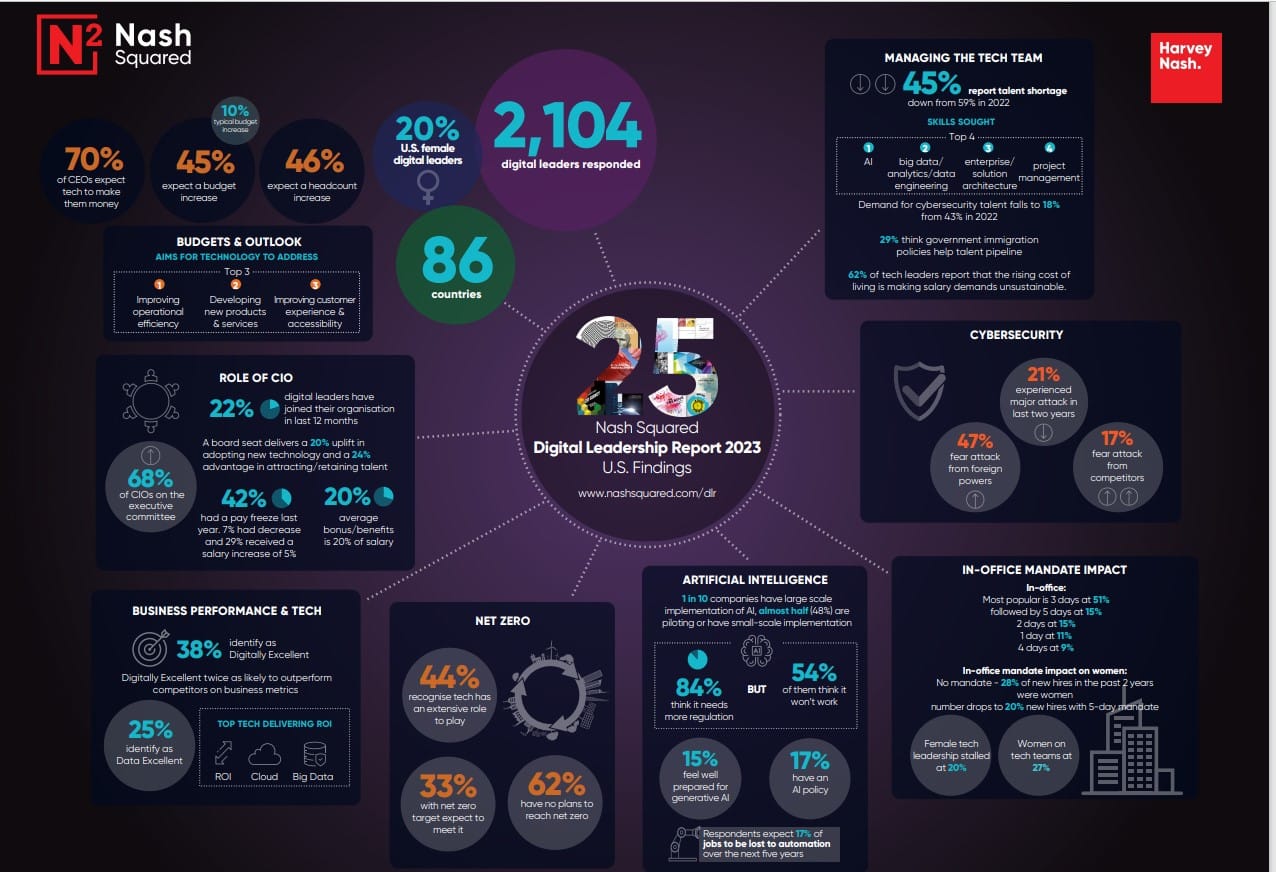Everybody knows the risks of reckless AI deployment by now, and that brands and businesses around the world are significantly challenged to use it responsibly, but feel they have no recourse but to move forward anyway in fear of getting left behind as the tech progresses. New research from talent and tech solutions firm Harvey Nash affirms those challenges, revealing that only 15 percent of global tech leaders surveyed report that they are prepared for the demands of generative AI, while nearly 9 in 10 (88 percent) want more structure behind the use of AI, saying stronger regulation is essential.
This is according to the firm’s 25th annual Digital Leadership Report, the longest-running annual survey of technology leadership, published by Harvey Nash parent company Nash Squared. The global study of more than 2,000 technology leaders also finds that despite the explosive predicted market growth of AI, it isn’t yet as widely used as many think—only 1 in 10 U.S. organizations report having large-scale implementation of AI, but almost half (48 percent) are piloting or conducting small-scale implementation. And despite the concerns about a lack of regulation, 61 percent of tech leaders worldwide say it won’t be effective anyway (54 percent in the U.S. say the same). And as we know, those mounting challenges are compounded by the fact that AI is the number one reported tech skills shortage in the U.S.

“Despite the attention around AI, the application and adoption of AI is really in its nascent stage,” said Jason Pyle, president of Harvey Nash US & Canada Market, in a news release. “What our survey findings reveal is that the technology behind AI is moving faster than the strategies and policies to support it, and tech leaders are finding themselves squeezed in the middle. As we look ahead to 2024, we expect tech leaders to focus on a few key areas within AI: developing more guidelines around the use and application of AI, putting safety and privacy front and center, and demonstrating its ROI and metrics.”
Tech leaders planning for cautious investment
After the hypergrowth of 2021 and 2022, the recent slowdown, and aggressive monetary tightening, digital leaders are still optimistic about 2024 growth: 45 percent of U.S. tech leaders expect an increase in their budgets (44 percent of global tech leaders say the same), and almost half (46 percent) of U.S. leaders expect to increase headcount, similar to 50 percent of global leaders who say the same.
Salary changes have been impacted by the economic slowdown and high inflation. Sixty-two percent of tech leaders report that the rising cost of living is making salary demands unsustainable. About half report salary has either stayed the same (42 percent) or decreased (7 percent) year-over-year. Twenty-nine percent (29 percent) received a salary increase of 5 percent, and any larger salary increases drop off significantly after that.
Return-to-office mandates result in fewer female tech workers
The survey found that when there is a high number of mandated days in the office, fewer females choose to be part of the tech team there. For companies without mandated in-office days, 28 percent of global tech new hires in the last two years are female. That number drops to 22 percent at companies with a mandated five days in the office.
Almost half (48 percent) of U.S. companies surveyed require some level of in-office time. The most popular number of required in-office days is overwhelmingly three, with 51 percent setting that expectation, compared to 15 percent requiring five days, 15 percent requiring two days, 11 percent requiring one day, and 9 percent requiring four days.
In general, female representation on tech teams remained the same year-over-year, globally at 23 percent and slightly higher in the U.S. at 27 percent. Women in leadership roles stalled, remaining at 14 percent year-over-year globally and dropping from 21 percent to 20 percent in the U.S. since last year.
Skills shortage eases slightly but remains a challenge
Forty-five percent of U.S. tech leaders said the skills shortage is preventing them from keeping pace with change. While this is down from 69 percent in 2021 and 59 percent in 2022, this year’s number is primarily a result of the slowing market and reduced overall hiring.
AI, technical architecture, big data/analytics/data engineering, enterprise/solution architecture, and project management are the top five skills in demand in the U.S. The same skills shortages are found globally, with the only exception that AI did not make the global top five needed skills.
In recent years, cybersecurity skills have occupied the top three most scarce skills, but this year it’s seen one of the largest falls in demand. In the U.S, the number of tech leaders struggling to find cybersecurity talent has dropped sharply from 43 percent to 18 percent.
A board seat helps outperform the competition
Over two thirds (68 percent) of global tech leaders are members of the operational board/executive management team, the highest level since 2017 (71 percent).
When technology leaders are given a seat at the top table, this delivers advantages over the competition, including a 20 percent uplift in adopting new technology and a 24 percent advantage in attracting and retaining talent.
Sign up here to receive the report when it’s released on Nov. 9.
In its 25th year of publication, the 2023 Nash Squared Digital Leadership Report is the world’s largest and longest running survey of senior technology decision makers. Launched in 1998 and previously called the CIO Survey, it has been an influential and respected indicator of major trends in technology and digital for over two decades. This year the survey of 2,104 technology/digital leaders took place between June 22, 2023 and September 18, 2023 across 86 countries.








